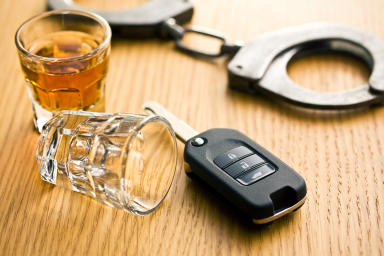Maryland DUI Laws

Maryland motorists rely more on automobiles than other modes of transportation. In 2021, around 62% drove to work, while 7% carpooled, according to the Bureau of Transportation Statistics. Being on the road, however, has its inherent risks. In 2022, 5,777 impaired driving crashes were recorded, a decrease of 11.7% from 6,540 in 2021. Injury-related crashes were also down, from 1,905 cases in 2021 to 1,704 in 2022. Accidents that resulted in fatalities were down as well by 12.9% within the same period.
The state seeks to further decrease these incidents through multiple regulations. One is sobriety checkpoints. Similar to neighboring Virginia, Maryland considers these checkpoints legal. Another way that the state implements measures to curb DUI accidents is through ignition interlock programs. These are imposed on all DUI offenders.
When it comes to impaired driving accidents, victims should know when to file claims against liable parties. This article provides such information. It also includes the state caps on damages. In addition, it explains how plaintiffs can still recover compensation despite Maryland’s pure contributory negligence system. It describes penalties related to different DUI or DWI charges for offenders as well.
General DUI Laws in Maryland
It is illegal for individuals to drive under the influence of drugs or alcohol. Also considered unlawful in Maryland is attempting to drive. Walking back to the car with keys in hand while intoxicated may be viewed as an attempt to drive.
Additionally, someone in actual physical control of the vehicle may be charged with DUI. Courts determine whether someone does indeed control their vehicle through multiple factors, like if the engine is running, the location of the ignition key, and whether the driver is asleep or awake. In some instances, it may be that the engine is running, but it does not mean the individual is in actual physical control of the car. It might indicate that they are just sleeping off, especially if they are in the backseat.
Maryland residents can be charged with DUI even if they are on private property. The logic behind this, as seen in Rettig v. State, is that intoxicated individuals, in their befuddled or confused state, may leave their private property and lead them to entering public streets or highways and cause damage to other people.
Besides DUI, the term DWI is also used to charge impaired drivers. The difference between the two is relatively straightforward. Those caught with a 0.07 blood alcohol concentration level are charged with DWI. Meanwhile, individuals with a BAC level of 0.08 or more face DUI-related penalties. This level is also considered a “per se” or automatic DUI charge.
There are two types of tests that police officers in Maryland employ to determine intoxication. The first is the use of field sobriety tests. These typically involve making someone stand on one leg and walk and turn. They might also need to perform the finger-to-nose test and the modified Romberg test.
The other type involves breath, urine, or blood samples. Warrants are required for blood tests. These are also mandatory in accidents involving serious injuries or deaths. But police officers cannot draw blood, as state law specifies they can only direct qualified medical personnel to perform the procedure. Note that chemical tests fall under implied consent laws in Maryland. In other words, drivers inherently agree to such tests when their behavior constitutes reasonable suspicion of alcohol or drug-related intoxication.
Aggravated DUI
Aggravated DUI, as the term conveys, is a more severe offense than a standard DUI. The factors that lead to harsher penalties consist of a variety of behaviors. These range from driving drunk with a minor to having a BAC level of 0.15. The latter behavior resulted in 124 fatalities from DUI-related accidents in Maryland in 2021.
Applicability to Cyclists
Bicycles are considered vehicles in Maryland law. Cyclists, therefore, possess the same duties and rights as other motorists. However, this similar treatment also means bicycle users can get a DUI or DWI charge. Incidentally, the same rules apply to users of electric bicycles.
Underage DUI Laws in Maryland
According to state data, 98 drivers aged 20 and below were injured in 2021 due to alcohol or drug intoxication. Another troubling statistic is that among high schoolers in Maryland surveyed in 2021, 4.1% mentioned that they drove after consuming alcohol within the past 30 days.
Maryland follows numerous laws that seek to suppress such behavior. One is the state’s zero-tolerance policy. No individual under the legal drinking age of 21 must have alcohol within their system while driving. To put it straightforwardly, any BAC level that exceeds 0.00 is illegal for underage drivers.
Another way that the state seeks to decrease these incidents is through restrictions on underage alcohol possession and consumption. Both of these are prohibited, with limited exceptions. For instance, those who receive alcohol from their immediate family can hold and drink such beverages. The state also allows the consumption and possession of alcohol in religious ceremonies. Additionally, those who work in licensed businesses may serve alcoholic beverages.
DUI-Adjacent Laws in Maryland
Unlawful Possession of Marijuana in a Vehicle
Maryland decriminalized marijuana use for recreational purposes in 2023. Given this, the smell of marijuana is no longer an adequate reason for police officers to conduct a vehicle search. It is also worth noting that the use of the drug for medical purposes has been legal since 2017.
Despite these regulations, marijuana remains illegal in specific amounts. For example, possession of 1.5 to 2.5 ounces for personal use leads to $250 in fines. The penalties increase to a maximum $1,000 fine and one year in prison if the individual holds between 2.5 ounces and 50 pounds of the drug. For those possessing 50 pounds or more of marijuana, they can expect penalties of at least five years in prison and not more than $100,000 in fines.
Boating Under the Influence
Operating vessels while intoxicated from drugs, alcohol, or both is illegal in Maryland. Like those driving vehicles, boat operators with a BAC level of 0.08 are automatically charged with DUI.
Those arrested for operating vessels under the influence may claim they are legally entitled to use drugs. However, this is not allowed under state law. The defense wherein the person is unaware of the drug’s effects on their operating ability, meanwhile, is permitted.
The penalties for offenders depend on their prior convictions. First-time violators, for instance, face up to a year in prison, a maximum $1,000 fine, or both. On the other hand, third-time offenders have to deal with imprisonment not exceeding three years or up to $3,000 in fines. Those who refuse chemical tests or test with a 0.08 BAC level result can be prohibited from operating vessels.
These laws apply to boats registered in Maryland. It also encompasses vessels from foreign countries that are traversing state waters.
Open Container Laws
Passengers and drivers in Maryland cannot possess open containers of alcoholic beverages in vehicles. Incidentally, state law specifies that drivers may not be prosecuted for an open container if it belongs to another occupant.
There are exemptions when it comes to Maryland’s open container laws. For example, passengers who pay for transportation in vehicles like limousines, buses, and taxicabs do not have to follow such laws. Likewise, RV occupants need not worry about open containers as long as these are consumed within the vehicle’s living quarters.
What Are the Penalties for a DUI/DWI in Maryland?
Marylanders charged with DUI or DWI face multiple consequences. The seriousness of such penalties relies on the individual’s conviction history and the degree of the injuries they caused. Typically, those caught driving while intoxicated are charged with a misdemeanor. A felony charge, though, applies in certain situations. These include cases involving manslaughter or if the BAC level is over 0.20.
Those whose licenses were suspended can register for a restricted permit. Also known as a hardship license, it helps Marylanders maintain their driving privileges, but only to essential destinations like school and work. Note that in some cases, employers need to verify the individual’s employment in writing as part of the application process.
Regarding demerit point accumulation, if a person racks up 8 to 11 points within two years, they could face license suspension. However, accumulating 12 points is grounds for the revocation of their license.
Penalties for Minors
Underage drivers caught under the influence of intoxicants are required to participate in the state’s ignition interlock program. Refusal to do so leads to a license suspension. Other penalties include fines that increase depending on prior conviction history. For instance, first-time offenders must pay up to $500 in fines. Those apprehended for the second or subsequent time, on the other hand, face a $1,000 fine.
Implied Consent Penalties
Refusing chemical tests leads to penalties in Maryland. The harshness of these penalties depends on whether the driver declined the first time or in subsequent cases. Those who initially turned down such tests can have their license suspended for 270 days. Conversely, second or subsequent offenders face a two-year suspension of their license. Individuals may request an administrative hearing within 30 days of arrest to avoid suspension.
Dram Shop and Social Host Liability Laws in Maryland
Similar to neighboring Virginia, Maryland does not have dram shop laws. To put it differently, the Old Line State does not address in its statutes the liability of establishments that serve alcohol.
However, Maryland does have laws regarding social hosts or non-commercial alcohol providers. Those who knowingly provide alcohol to individuals under 21 face a range of penalties. These include fines between $2,500 and $5,000, as well as up to one year in prison. Notably, hosts who know or ought to have known that the individual would drive after consuming alcohol, which resulted in death or serious injuries, face much more severe penalties.
Additionally, note that some municipalities and counties have ordinances about social hosts. Some of these include the cities of Baltimore and Frostburg and some parts of Baltimore County. Such ordinances aim to control underage drinking and nuisance complaints through fines.
These vary per jurisdiction. One example is the city of Baltimore. It imposes a $500 fine for first-time offenders. Those cited for the second time within 12 months of the first offense face a $1,000 fine.
Dram Shop and Social Host Liability Insurance
Despite the relative lack of rules regarding liability for dram shops and social hosts, the potential for lawsuits is not zero. Thus, businesses and individuals can cover legal costs through liability insurance.
One thing to note when purchasing policies from insurers is that each state has a grade that represents the liability exposure from alcohol-related incidents. The higher the grade, the more the state imposes responsibility on a business or individual. Currently, Maryland has a grade of 0. This number indicates that those seeking liability insurance in the Old Line State can obtain lower rates than in other states.
Maryland’s low liability hazard for businesses and individuals does not mean lawsuits are impossible. Insurers offer two types of policies that allow protection from legal costs:
Liquor liability insurance. This policy helps dram shops deal with costs like those involving unruly patrons who commit battery or assault.
Host liquor liability insurance. This solution allows policyholders to manage alcohol-related damages from special events.
How Much Can Someone Sue for a Drunk Driving Injury in Maryland?
Marylanders seeking damages from defendants in a DUI accident must prove four elements. These are:
Duty. Plaintiffs need to exhibit that the defendant possesses a responsibility of care to others.
Breach. Plaintiffs must show that the defendant failed to meet their duty of care.
Causation. Plaintiffs need to demonstrate that the defendant’s actions, like operating a vehicle while intoxicated, breached their duty of care and resulted in injuries.
Damages. Finally, plaintiffs must show that they suffered damages from the defendant’s conduct.
Those who are able to demonstrate these four elements effectively can obtain full damages for their injuries from defendants. Victims contributing to their accidents, though, are often seen in many cases. Plaintiffs in Maryland must be aware that it is one of the few states nationwide that follow the pure contributory negligence system. In other words, if someone is even 1% responsible for the accident, they cannot recover compensation.
One way for plaintiffs to still obtain damages for their injuries is through the last chance doctrine. This principle means that the defendant did not take the final chance to avoid the accident with the plaintiff. The other exception is cases involving injured children ages five or younger.
Types of Damages
Compensatory damages are awards that assist plaintiffs looking to cover economic and non-economic losses. Economic losses are tangible costs like lost wages, medical bills, and vehicle repair expenses. Non-economic losses, meanwhile, cannot be calculated based on objective data. These are subjective, like loss of companionship and mental anguish.
There are also punitive damages. These are awarded to plaintiffs by courts seeking to punish defendants for their conduct. DUI victims need to prove that the liable party committed acts of actual malice to obtain punitive damages.
Caps on Damages
There are no limits on the economic or punitive damages plaintiffs in Maryland can receive from defendants. Caps on non-economic damages exist, though. Lawsuits filed on or after October 1, 1994, could only receive $500,000 for non-economic damages. This number increased by $15,000 every year after 1995. In 2022, this limit was set at $920,000.
Another thing to note is that in wrongful death cases involving two or more claimants, the $920,000 cap may be increased by 150% to $1.38 million. State law also allows filing a separate claim, known as a survival action. Unlike wrongful death claims pursued by the victim’s representatives or family members, survival actions are filed to compensate the deceased person. Since they are no longer alive, their representative acts on their behalf. The limit on non-economic damages for survival actions has been $920,000 since 2022. This figure will be added to $1.38 million to give us $2.3 million.
The Statute of Limitations in Maryland
Maryland provides three years for DUI victims looking to obtain damages for their injuries from at-fault parties. Plaintiffs must file claims against defendants within three years from the day of the injury. The same three-year period also applies in cases involving wrongful death.
Likewise, if the plaintiff is a minor, they have three years after they reach the age of majority — 18 — to press legal action against the defendants.
There are some situations, however, where the three-year deadline does not apply. If the DUI victim was hurt by the state or its employees, they can file a claim under the Maryland Tort Claims Act. Those seeking damages from governmental entities must send a claim letter within one year of the injury date.
Resources for DUI Defendants and Folks Injured by an Impaired Driver in Maryland
Mothers Against Drunk Driving Maryland
The organization offers multiple services for those affected by drunk driving incidents in Maryland. One of these is victim impact panels. These classes bring together DUI offenders in the state with accident victims and survivors who tell stories of how they were affected by impaired drivers. One can find in-person panels near them through a map on the organization’s website. Others may check their eligibility for online classes through its impact panel verification checker. The organization also manages a 24/7 hotline that helps Marylanders looking for emotional support and seeking resources on victimization topics. It further assists victims in preparing impact statements. One may contact MADD Maryland at 1-877-623-3435.
Maryland Department of State Police
Since 1921, the department has been working to improve the safety of residents in Maryland. Their responsibilities include coordinating initiatives between federal and local law enforcement agencies. It has experience dealing with cross-border crime. The department also handles vehicle safety inspections through its Automotive Safety Enforcement Division. This program oversees around 1,600 stations across Maryland. It conducts post-crash investigations to check whether a vehicle meets the state’s safety standards. Another area that the department deals with through its Central Records Division is crash reports. One can expedite their request by filling out an online form. Individuals may also view the webpage that details the steps they must take to access accident reports.
Maryland Insurance Administration
The agency has been in operation since 1872. It oversees the insurance industry of Maryland and conducts financial examinations of insurers to determine their solvency status. It also maintains a website that provides an overview of accessible matters to educate Marylanders on a variety of topics. These range from auto and boat insurance to policies that protect farm as well as business owners. Another area that the agency handles is insurance fraud. It has received various complaints involving medical providers who inflate their bills for services, insurance agents who pocket premiums, and individuals who complete false documents. One can submit a complaint regarding a fraudulent agent or company to fraud_referrals.mia@maryland.gov.
Expertise.com StaffAuthor
Step into the world of Expertise.com, your go-to hub for credible insights. We don't take accuracy lightly around here. Our squad of expert reviewers, each a maestro in their field, has given the green light to every single article you'll find. From rigorous fact-checking to meticulous evaluations of service providers, we've got it all covered. So feel free to dive in and explore. The information you'll uncover has been stamped with the seal of approval by our top-notch experts.




